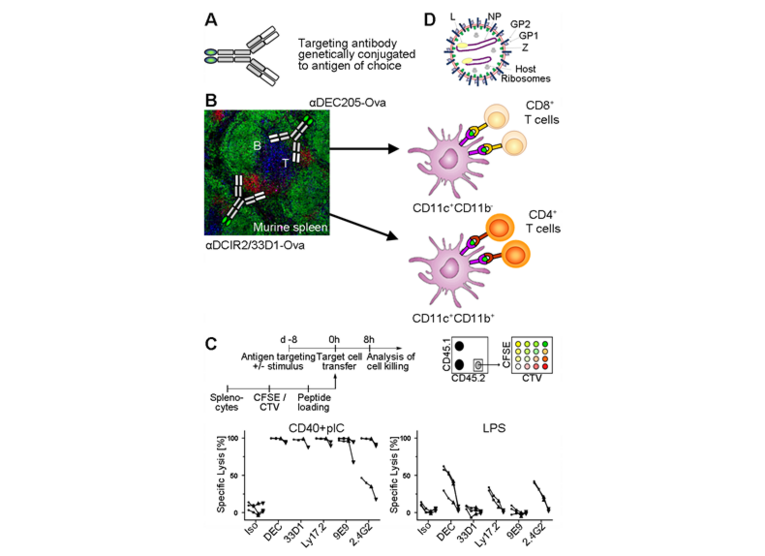LCMV as model for immune intervention by antigen targeting in chronic viral infections
DCs are key regulators of the immune system (Heidkamp et al., 2016). They recognise and engulf invading viruses and bacteria directly or indirectly by the uptake of infected cells. Endocytosed antigens are processed and presented as peptides complexed to MHC-I and MHC-II on the DC surface and subsequently recognised by antigen-specific T-cells. By delivering antigens to DCs by using a recombinant antibody-based system (Fig. 1A), we have previously shown that the antigen presenting DC subsets and their differentially expressed antigen processing machineries dictate the initiation of either CD4+ or CD8+ T-cell responses in vivo (Fig. 1A-C) (Dudziak et al., 2007; Kamphorst et al., 2010; Heidkamp et al., 2016; Neubert et al., 2014; Lehmann et al., 2016; Lehmann et al., 2017). Although the lymphocytic choriomeningitis virus (LCMV) is directed into multivesicular bodies (which are highly enriched for MHC-II, not MHC-I), the virus or its proteins must enter the cytosol allowing for CD8+ T-cell responses. This is partly dependent on molecules of the antigen processing machinery (such as ERAD, SEC61; Firat et al., 2007; Zehner et al., 2015) and might be independent on the cell subset the virus has entered. Importantly, there is evidence that LCMV antigens themselves contribute to the endosome-to-cytosol translocation, a process, which might also be dependent on the antigen processing machinery (Dudziak et al., 2007; Heidkamp et al., 2016) and the infected cell subtype. Therefore, we aim to understand immune intervention strategies of LCMV within the different DC subsets and other involved antigen-presenting cells (APCs).
To date it is not completely understood how LCMV interacts with and internalises into different DC subsets and other antigen-presenting cells (APCs). Therefore, the doctoral candidate will investigate the most commonly used LCMV variants, such as Armstrong and Clone 13, in in vivo and in vitro infection models for DCs and other APCs to directly visualise the virus' spatial localisation by fluorescent LCMV variants. The candidate will apply confocal immunofluorescence imaging, STED, and FACS approaches. In parallel, he/she will produce the already cloned LCMV-peptide-conjugated targeting antibodies for different endocytic active receptors on DCs, known to induce mainly a CD8 (DEC205) or CD4 (DCIR2) T-cell response, or both (FcγRIV) simultaneously. Thereby, these antigenic peptides (the immunodominant epitopes of the virus' glycoprotein (gp) and nucleoprotein (np) will be delivered to different DCs and other APCs (as in Lehmann et al., 2017). The candidate will study their efficiency under immunostimulatory conditions in vivo to reveal cellular and humoral immune responses by FACS, ELISA, and cytokine bead array (CBA). In parallel, the doctoral candidate will evaluate the potency of the individual LCMV peptides and their combinations for vaccination strategies in preventive, but most importantly in therapeutic settings, for chronic viral infections. Overall, this study will help to pinpoint the best strategies for immune intervention in chronic viral infections.




